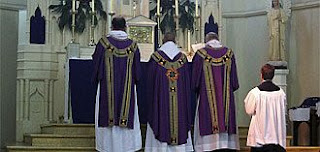With the General Synod of the Church of England discussing further details of its plans to enable the consecration of "women bishops" this week I somewhat hesitate to publicise the following story - I would not want to be thought in any way to encourage that sort of thing. However this incident from the fifth century may well be legendary in origin...
Yesterday, February 6th, was the feast of St Mél (d. late 5th or early 6th cenury). Mél (also Moel) is the early saint of Ardagh (county Longford). He is reputed to have been a Briton who went to Ireland with St. Patrick and who was made priest at Ardagh and he features not only in the early Lives of St Patrick but also in the Lives of St. Brigid of Kildare (to whom he is said to have given the veil). His feast on this day is recorded from the ninth century in the Martyrology of Tallaght and the Martyrology of Óengus.
There is more about him here.
Nathalie Stalmans and T.M.Charles-Edwards in their article on the saints of Meath in the
Oxford DNB say of St M
él:"The evidence for the early saints is predominantly from the Patrician texts, beginning with Tírechán's
Collectanea, written in the last quarter of the seventh century, but
Mél (
fl. 5th–early 6th cent.) of Ardagh (Ardachad) in modern co. Longford, is also a character of some importance in what has been claimed as the earliest life of Brigit, the so-called
Vita prima, and in her mainly vernacular life,
Bethu Brigte. The heirs of these saints, Patrick and Brigit, were competing for influence within the kingdom of southern Tethbae; Ardagh was the episcopal church of southern Tethbae, and the competition naturally centred on the principal church of the kingdom. Although there is no life of Mél, his cult seems to have been resilient. In the ninth century his feast day, 6 February, is recorded in the martyrology of Tallaght, and also in the text of the
Félire Óengusso: the
Félire chose the most important saints to include within its brief verses, one to each day of the year, and it is thus significant that the Irish saint chosen for 6 February was Mél. The connection between Mél and Patrick seems to have strengthened in the viking period: according to the saints' genealogies, his mother, Dar Erca, was Patrick's sister."
Pope John Paul II views the crozier of St Mel and the shrine of St Machan in 1979.
The originally ninth-century Crozier of St. Mel, discovered in 1863 near the site of the medieval cathedral, was initially believed to have been destroyed in 2009 in the Christmas Day fire in St. Mel's Cathedral in Longford town, but later reports say that at least part of it survived.
Image ardaghdiocese.org
However St Mél is said not just to have given St Brigid the veil, but to have made her a bishop. Yes, a bishop...
From the Liber Hymnorum: "It came to pass that Bishop Mél conferred on Brigit the episcopal order, although it was only the order of repentance that she desired for herself. And it is then that Mac Caille lifted up a veil over Brigit’s head ut ferunt periti; and hence Brigit’s successor is always entitled to have episcopal orders and the honour due to a bishop."
From the Book of Lismore: "For humility Brigit stayed so that she might be the last to whom a veil should be given. A fiery pillar rose from her head to the roof-ridge of the church. Then said Bishop Mél: “Come, O holy Brigit, that a veil may be sained on thy head before the other virgins.” It came to pass then, through the grace of the Holy Ghost, that the form of ordaining a bishop was read over Brigit. Mac-caille said, that a bishop’s order should not be conferred on a woman. Said Bishop Mél: “No power have I in this matter. That dignity hath been given by God unto Brigit, beyond every (other) woman.” Wherefore the men of Ireland from that time to this give episcopal honour to Brigit’s successor."
The abbesses of Kildare apparently retained this episcopal honour until a reforming Synod in 1152.
With such curious privileges around one can see why twelfth century Popes both before and after Strongbow and King Henry II were interested in reforming the Irish church.
We are not required to believe everything in an early saint's life. I suspect this story may originate in attempt to explain the particular traditional privileges of the abbess of Kildare, perhaps originating with the Celtic ( a dangerously overused term these days in respect of spiritual matters) tradition of a monastically led church, with the bishop less important than the abbot or abbess, and, I wonder, possibly in local land tenure customs and claims.
Prof. Charles-Edwards (he is the Professor of Celtic Studies here at Oxford) gives a detailed assessment of the life of St Brigid in his life of her in the recent
Oxford DNB which can be read
here and provides a valuable informed insight into the complexities of the era. This is a topic and period about which I know very little, but I do apprecaite the tangled nature of the sources and admire the skill of those who can disentangle them.
With acknowledgements to the posts by John Dillon and Maeve Callan on the Medieval Religion discussion group.






